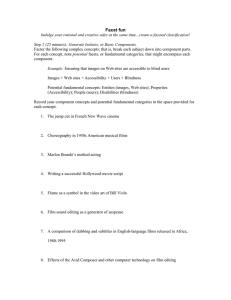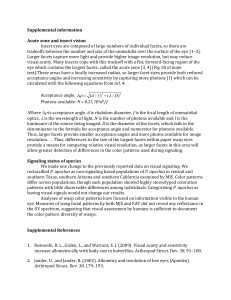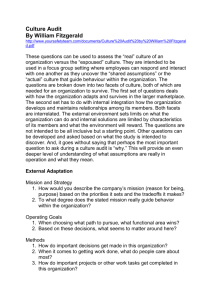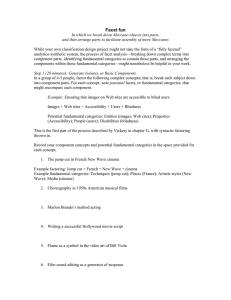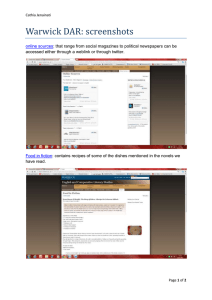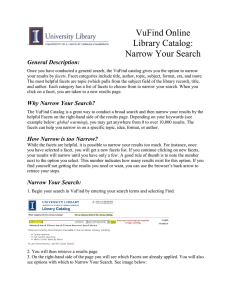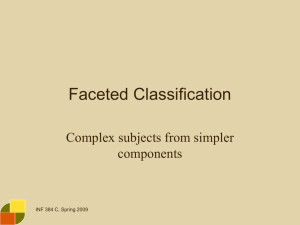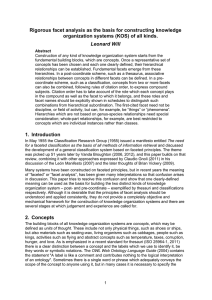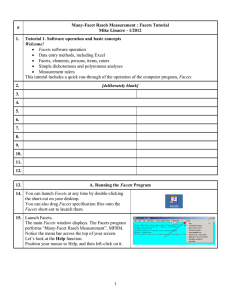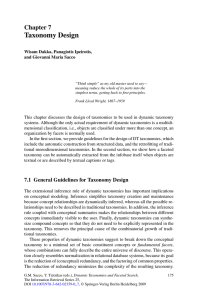Facet fun!
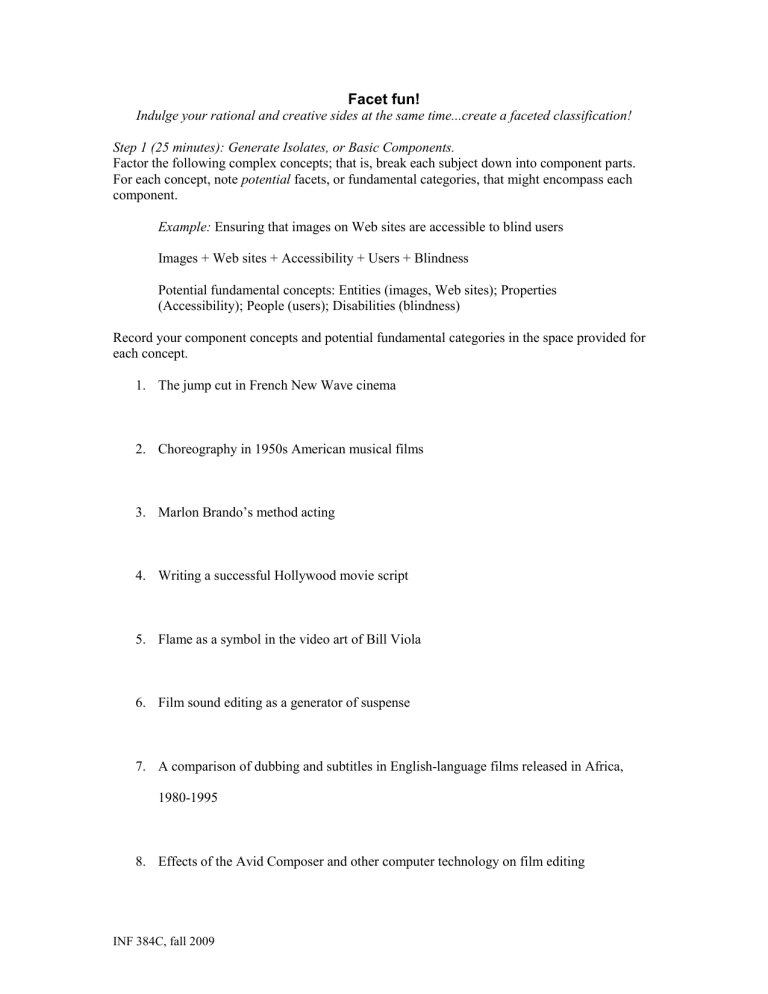
Facet fun!
Indulge your rational and creative sides at the same time...create a faceted classification!
Step 1 (25 minutes): Generate Isolates, or Basic Components.
Factor the following complex concepts; that is, break each subject down into component parts.
For each concept, note potential facets, or fundamental categories, that might encompass each component.
Example: Ensuring that images on Web sites are accessible to blind users
Images + Web sites + Accessibility + Users + Blindness
Potential fundamental concepts: Entities (images, Web sites); Properties
(Accessibility); People (users); Disabilities (blindness)
Record your component concepts and potential fundamental categories in the space provided for each concept.
1.
The jump cut in French New Wave cinema
2.
Choreography in 1950s American musical films
3.
Marlon Brando’s method acting
4.
Writing a successful Hollywood movie script
5.
Flame as a symbol in the video art of Bill Viola
6.
Film sound editing as a generator of suspense
7.
A comparison of dubbing and subtitles in English-language films released in Africa,
1980-1995
8.
Effects of the Avid Composer and other computer technology on film editing
INF 384C, fall 2009
9.
The role of women in Communist society as portrayed in Soviet propaganda films
10.
Staging objective event reinactments in documentaries
11.
Audience and critical reception of Academy-Award-winning movies
12.
Stylistic differences between Japanese and American computer animation
13.
Film scores in the spaghetti Western
14.
Nonlinear sequence and plot development in contemporary film
15.
Studio sets and location shooting: the relative effect on versimilitude in television dramas
Step 2 (25 minutes): Determine Facets to Group the Isolates.
Create a set of 5 to 9 facets, or fundamental categories, to contain all the components that you identified in step one. When appropriate, identify subfacets within a primary facet. (For example, in a facet of Schools, you might identiy subfacets “by grade level” and “by instructional philosophy” and “by subject-matter emphasis” to characterize, respectively, elementary schools,
Montessori schools, and performing-arts schools). Create a structure of facets and subfacets that would enable you to place all your component concepts from step 1.
To make this easier, first clarify the classification’s domain and targeted user group (for example, a classification to organize documents about Web site design for people with disabilities, for an audience of Web designers).
Begin with your ideas from each complex concept and see how those work.
Consider Spiteri’s principles for determining facets as you perform this exercise:
Differentiation: When creating facets that split a group of entities, choose a principle of division that cleanly splits the group into component parts. For example, dividing people by gender creates two generally unambiguous categories. However, dividing socks according to color can cause problems when considering socks with multiple colors; color does not provide the same level of differentiation for socks as gender does for people.
INF 384C, fall 2009
Relevance: Choose facets based on the purpose of the classification. A classification of gardening might divide terrain by sun exposure, but a classification of cycling might divide terrain by elevation.
Ascertainability: When possible, choose facets that can be reliably measured.
Permanence: When possible, choose facets that will not change over time.
Homogeneity: Each facet (or subfacet) should represent a single principle of division.
For example, if we are classifying socks, we should not see colors and patterns in the same array. We would need to separate patterns and colors.
Mutual Exclusivity: The contents of any two facets (or subfacets) should not overlap (that is, they should be mutually exclusive). If we are dividing shoes by heel height and by form, we should not find any mixing of values for either facet (for example, we should not see “high-heeled pumps” in the form facet, but merely “pumps”).
Create a structure of facets and subfacets that would enable you to place all your component concepts from step 1.
Record your facet/subfacet structure on the following page.
INF 384C, fall 2009
Domain of classification:
Targeted user group:
Facet structure
INF 384C, fall 2009
Step 3 (20 minutes): Engage Another Group’s Approach.
Exchange your facet structure with another group. Evaluate the other group’s structure.
Provide, in brief sentences, three potential improvements to the other group’s classification and three elements that were done well. It may be tempting to blow this off, but don’t! Being able to provide constructive yet critical feedback to your colleagues is a vital skill in professional life.
In performing your evaluation, consider the following:
Is the structure complete? Can all the component concepts be included?
Is the structure cohesive? Can you discern a logic to it, and a sense of balance?
Is the structure hospitable? That is, would it be easy to add facets, subfacets, and values?
Are the facets relevant to the domain and user group?
Are the facets homogeneous and mutually exclusive? (Would it be possible to put a single component concept in multiple places in the facet structure?)
Record your feedback on the following page.
INF 384C, fall 2009
INF 384C, fall 2009
Evaluation of another group’s facet structure

